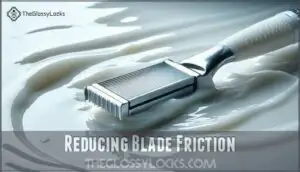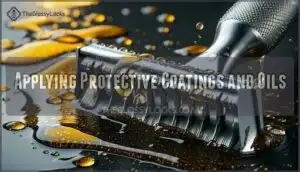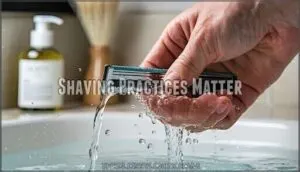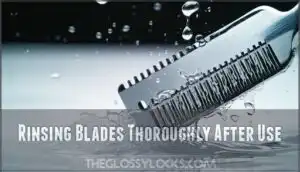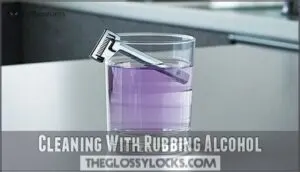This site is supported by our readers. We may earn a commission, at no cost to you, if you purchase through links.

Store your razor in a dry spot away from humidity, not on the shower shelf where it’ll rust faster than yesterday’s bread. Clean blades weekly with rubbing alcohol to remove buildup and bacteria.
Skip the aggressive tapping against the sink; it damages delicate edges. Always shave wet, well-hydrated skin to reduce friction and blade wear.
These simple habits can easily double your blade life, but there’s more to this blade-saving game.
Table Of Contents
- Key Takeaways
- Razor Blade Care
- Extending Blade Life
- Shaving Practices Matter
- Razor Maintenance Tips
- Optimizing Razor Performance
- Frequently Asked Questions (FAQs)
- How can I make my razor blades last longer?
- How do you extend the life of a razor blade?
- Why do my razor blades dull so fast?
- How often should I replace my razor blade?
- Can water temperature affect blade sharpness?
- Which blade brands last the longest?
- Do expensive blades really last longer?
- Should I use different blades for different seasons?
- Conclusion
Key Takeaways
- Dry your razor completely after each use – Moisture causes rust and dulls blades faster than anything else, so shake off water and pat dry with a clean towel.
- Store your razor in a dry location away from humidity – Skip the shower shelf and keep it in a medicine cabinet or dry area to prevent corrosion that kills blade sharpness.
- Clean your blade weekly with rubbing alcohol – This removes bacteria buildup and prevents water spots while maintaining the cutting edge for longer performance.
- Shave with proper technique using wet, hydrated skin – Warm water softens hair, reduces friction, and prevents the aggressive pressure that damages delicate blade edges.
Razor Blade Care
You can dramatically extend your razor blade’s life by mastering three simple care fundamentals that most people completely ignore.
The difference between a blade lasting two weeks versus six months often comes down to how well you dry, store, and clean your razor after each shave.
Proper Drying Techniques
Moisture is your blade’s worst enemy. After each shave, shake off excess water and gently pat your razor dry with a clean towel.
Water is your razor’s biggest enemy—dry it completely after every shave to prevent rust and keep edges sharp longer.
Don’t just toss it wet into your medicine cabinet—that’s a recipe for rust and dull edges. Air drying works too, but thorough water removal prevents corrosion that kills blade sharpness.
Proper drying methods can extend blade life substantially. Regular straight razor care techniques are essential to maintain the blade’s quality and longevity.
Storage Methods to Prevent Corrosion
After proper drying, where you store your blade determines whether it’ll last weeks or months.
Storing razors upright prevents bacterial growth and corrosion that kills blade sharpness. Smart storage creates a moisture barrier that protects your investment.
- Dry Storage: Keep razors in low-humidity areas like medicine cabinets, not steamy bathroom counters
- Razor Cases: Use ventilated cases or blade wrapping to maintain airflow while blocking moisture
- Moisture Control: Store blades in mineral oil or apply protective coatings for corrosion prevention
Cleaning and Maintenance Routines
Regular blade sanitizing prevents bacterial buildup that dulls your razor’s edge prematurely.
Rinse thoroughly after each stroke to remove debris and shaving cream.
Weekly razor disinfecting with rubbing alcohol eliminates germs while preventing water spotting on metal surfaces.
Don’t forget handle cleaning—oils from your grip attract dirt.
Metal polishing monthly keeps your razor performing like new, boosting blade longevity through proper razor maintenance and hygiene.
Extending Blade Life
You can dramatically extend your blade’s lifespan by reducing friction, maintaining the cutting edge, and protecting against corrosion.
These proven techniques turn a two-week blade into a six-month workhorse, saving you money while delivering consistently smooth shaves.
Reducing Blade Friction
Friction kills your blades faster than you’d think.
Smart blade lubrication starts with quality shaving cream—thick lather creates a protective barrier that enhances glide enhancement.
Proper skin preparation using warm water softens hair and reduces drag.
Check your razor alignment; misaligned blades create unnecessary friction.
PTFE-coated blades offer superior friction reduction compared to standard steel.
These simple shaving technique adjustments can dramatically improve blade longevity.
Understanding the concept of blade friction reduction is essential for extending the life of your razor blades, which involves reducing unwanted friction and using the right materials like PTFE-coated blades.
Using Sharpening and Honing Methods
Sharp blades don’t happen by accident—they’re crafted through deliberate sharpening techniques.
Honing with 4,000-8,000 grit stones restores your razor’s edge and extends blade durability up to five times.
Master stropping techniques using leather or canvas for edge realignment between honings.
Your razor tuning arsenal needs just two hones: coarse and fine.
Regular blade sharpening with proper sharpening tools maintains that microscopic apex, preventing nicks and irritation.
To achieve superior results, understanding the straight razor process is essential for maintaining a sharp edge.
Applying Protective Coatings and Oils
Your blade’s defense starts with a thin protective barrier.
Apply blade oil or mineral oils after each shave to create a moisture shield that prevents rust formation.
Hydrocarbon coatings and razor wax work similarly, sealing metal surfaces from humidity.
This simple coating types approach transforms blade durability, extending life substantially while maintaining razor hygiene and peak shaving performance.
Shaving Practices Matter
Your shaving technique directly impacts how long your blades stay sharp and effective.
Smart practices like proper skin preparation and gentle strokes can dramatically extend blade life while giving you better shaves.
Shaving on Wet and Hydrated Skin
Hydration benefits your blade longevity substantially.
Pre-shave routine with warm water temperature softens hair up to 40%, reducing friction and extending sharpness.
Lubrication importance can’t be overstated—wet skin creates a protective barrier that prevents rapid dulling, and these shaving techniques and shaving tips transform your razor blade longevity, making each blade last longer while reducing skin sensitivity.
Using Fewer Blades for Longer Life
Counter-intuitively, using fewer blades actually boosts razor blade longevity substantially.
Less is more when it comes to blade count—single blades outlast multi-blade cartridges every time.
Multi-blade cartridges create unnecessary friction and wear patterns that dull edges faster.
Single blade advantages include reduced clogging, easier cleaning, and better sharpness preservation.
Consider switching to safety razors or single-blade designs.
This simple razor type choice can double your blade replacement intervals while improving your shave quality and reducing blade rust prevention needs.
Avoiding Aggressive Shaving Techniques
Your razor blade care routine extends beyond maintenance – how you shave matters too.
Aggressive shaving techniques destroy blade edges faster than dull butter knives through toast. Think gentle pressure, proper blade angle, and quality lather for maximum blade longevity.
A vital step involves pre-shave skin preparation for a smoother shave.
- Apply gentle pressure – Let the razor’s weight do the work, not your heavy hand
- Master your blade angle – Keep it around 30-45 degrees for efficient cutting without edge damage
- Use short strokes – Quick, controlled movements prevent blade flex and maintain sharpness longer
Razor Maintenance Tips
Your razor’s maintenance routine can turn a week-long blade into a month-long performer with just a few simple steps.
These three techniques work together to keep your blade sharp and your wallet happy.
Stropping Blades for Edge Realignment
Stropping realigns your blade’s microscopic edge without removing metal, like tuning a guitar string.
Run your razor across denim stropping material using light stropping pressure at the correct stropping angle—spine leading, blade trailing.
Leather alternatives work too, but avoid compound application for daily maintenance. This simple technique doubles blade life by correcting tiny bends from shaving.
You can purchase denim stropping supplies online, which is a great way to implement stropping and maintain your razor with daily maintenance.
Rinsing Blades Thoroughly After Use
After stropping brings back your blade’s edge, you’ll want to rinse thoroughly after each stroke during shaving.
Use lukewarm water temperature and maintain consistent rinsing frequency to prevent debris removal issues. Tap water quality affects residue buildup—harder water leaves mineral deposits that dull blades faster.
Proper razor cleaning through regular rinsing extends razor blade longevity substantially, making this razor maintenance step non-negotiable for ideal shaving techniques.
To further enhance hygiene, consider weekly alcohol disinfection to eliminate bacteria and ensure proper razor cleaning.
Cleaning With Rubbing Alcohol
Beyond thorough rinsing, alcohol concentration of 70% isopropyl provides superior disinfection benefits for razor cleaning.
This percentage maximizes bacteria elimination while ensuring effective residue removal from blade surfaces.
Pour alcohol into a small container, submerge your razor head for 30 seconds, then air dry completely.
This routine prevents rust formation and extends shaving blade longevity substantially.
Follow safety precautions by using alcohol in well-ventilated areas away from heat sources for ideal razor maintenance results.
Optimizing Razor Performance
Getting the most from your razor isn’t just about the blade itself—it’s about matching your tools to your unique needs.
You’ll maximize blade life by selecting the right blade for your skin type, timing your shaves strategically, and treating your razor like the precision instrument it is.
Choosing The Right Blade for Skin Type
Your skin type determines which blade material and coating work best for longevity. Match your needs correctly, and you’ll get substantially more shaves per blade.
Here’s how to choose based on your skin sensitivity:
- Sensitive skin – Pick PTFE-coated stainless steel blades with mild aggression for reduced irritation
- Oily skin – Choose sharp, uncoated blades that cut through sebum without clogging
- Dry skin – Select blades with lubricating strips to prevent micro-cuts and maintain hydration
- Thick hair – Use platinum-coated blades for enhanced durability and consistent shaving blade performance
- Combination skin – Try adjustable razors with balanced blade types for different facial zones
Consider that pivoting heads adapt to facial contours, minimizing pressure.
Adjusting Shaving Frequency for Blade Longevity
Your shave frequency game-plan directly impacts blade longevity and performance.
Daily shavers typically replace blades every 5-7 shaves, while every-other-day shavers can stretch blade life to 2-3 weeks.
Match your shaving habits to your hair thickness and skin sensitivity—coarse hair demands more frequent changes regardless of schedule, while fine hair allows longer intervals between replacements for superior shaving blade performance.
Handling and Storing Razors for Durability
Handle your razor like a prized possession. Store it upright in a dry cabinet to prevent Handle Corrosion and blade damage.
Keep blade material away from humidity with Environment Control measures. Invest in Travel Cases for protection during trips.
Proper razor storage beats careless handling every time. These razor blade tips transform your razor longevity game completely, with proper storage being key.
Frequently Asked Questions (FAQs)
How can I make my razor blades last longer?
Proper blade care can extend razor life from two weeks to six months.
Dry your blade thoroughly after each use, rinse between strokes, and strop on denim for 10-20 strokes to realign the edge and prevent corrosion, which involves complete concepts like realigning the edge.
How do you extend the life of a razor blade?
Dry your blade thoroughly after each use and store it upright to prevent moisture buildup.
Clean with rubbing alcohol, strop on denim for 10-20 strokes, and you’ll substantially stretch blade life.
Why do my razor blades dull so fast?
Your blades turn dull lightning-fast because you’re not drying them properly after each shave.
Moisture causes micro-corrosion that weakens the edge.
You’re also pressing too hard and shaving dry skin, which creates friction that chips the blade’s delicate metal edge.
How often should I replace my razor blade?
Replace your razor blade every 5-7 shaves for cartridge razors, or weekly for safety razors.
Signs it’s time: tugging, irritation, or multiple passes needed.
Fresh blades prevent nicks and give smoother shaves.
Can water temperature affect blade sharpness?
Like a double-edged sword, hot water can dull your blade faster than cold. Heat expands metal, making edges more fragile and prone to microscopic damage during shaving.
Which blade brands last the longest?
Japanese Feather blades typically outlast most competitors, delivering sharp performance for 5-7 shaves. Premium brands like Gillette Silver Blue and Personna also excel in longevity, while budget options fade faster.
Do expensive blades really last longer?
Expensive blades don’t automatically last longer. Performance depends more on steel quality and coating than price. Premium brands often use better metallurgy, but proper care matters most for longevity.
Should I use different blades for different seasons?
Changing blades seasonally is like switching tires for different weather conditions.
Winter’s dry air preserves blade edges longer, while summer’s humidity accelerates dulling.
You’ll get better performance matching blade aggression to seasonal skin sensitivity.
Conclusion
Surprisingly, your wallet isn’t the only thing that benefits from these razor blade longevity tips—your skin will thank you too.
Fresh, well-maintained blades deliver smoother shaves with less irritation than dull ones that tug and scrape.
You’ve learned that proper drying, smart storage, and gentle handling can triple your blade life.
It’s not rocket science, just good habits that save money and improve your grooming routine.
- https://www.reddit.com/r/lifehacks/comments/1hlq4q4/lifehack_eternal_razor_blades/
- https://www.theenglishshavingcompany.com/blog/keep-razor-blades-sharp/
- https://www.elegantgbarbershop.com/12-quick-tips-for-maintaining-your-razor-and-shaving-gear/
- https://toilettreeproducts.com/products/blew-razor-blade-dryer
- https://www.gillettevenus.com/en-us/womens-shaving-guide/how-to-shave/how-often-should-i-change-razor-blades/

